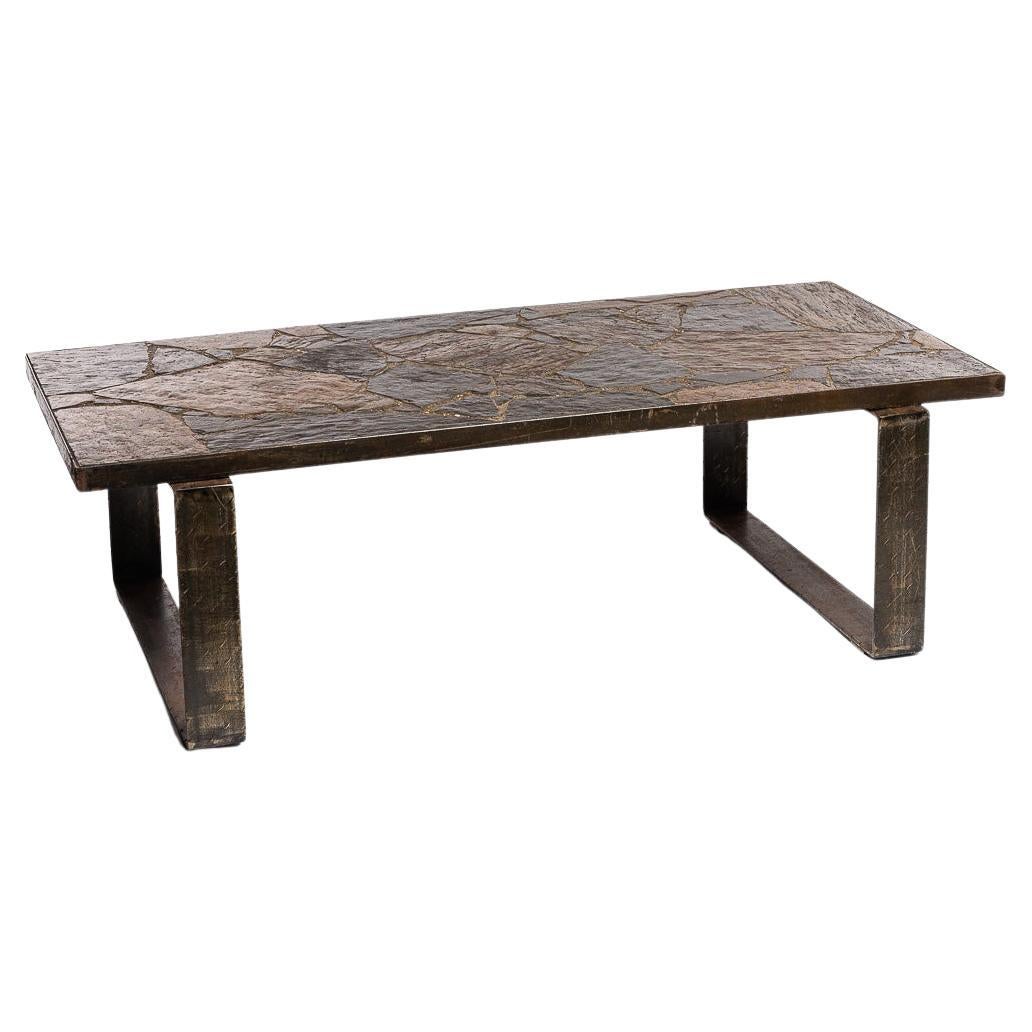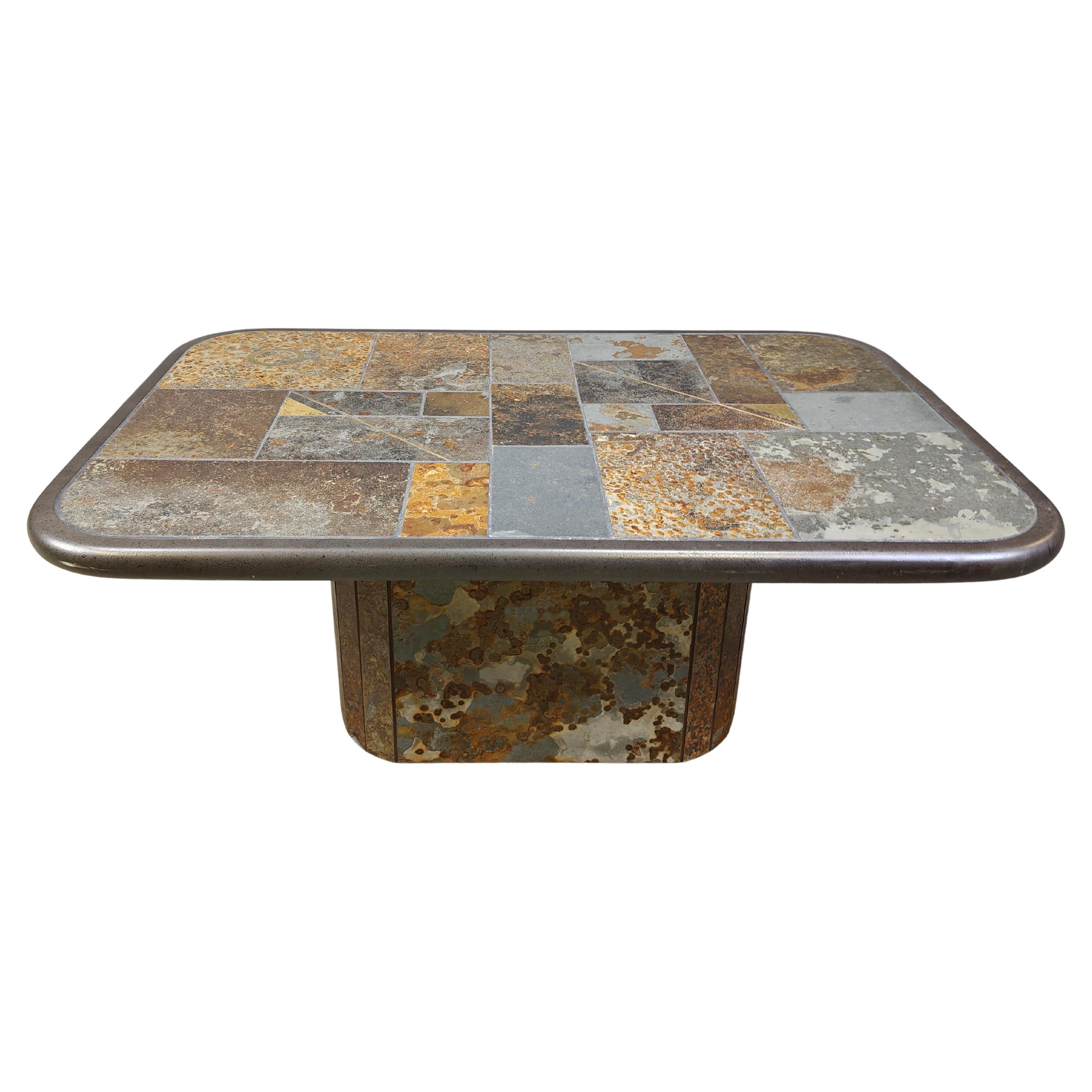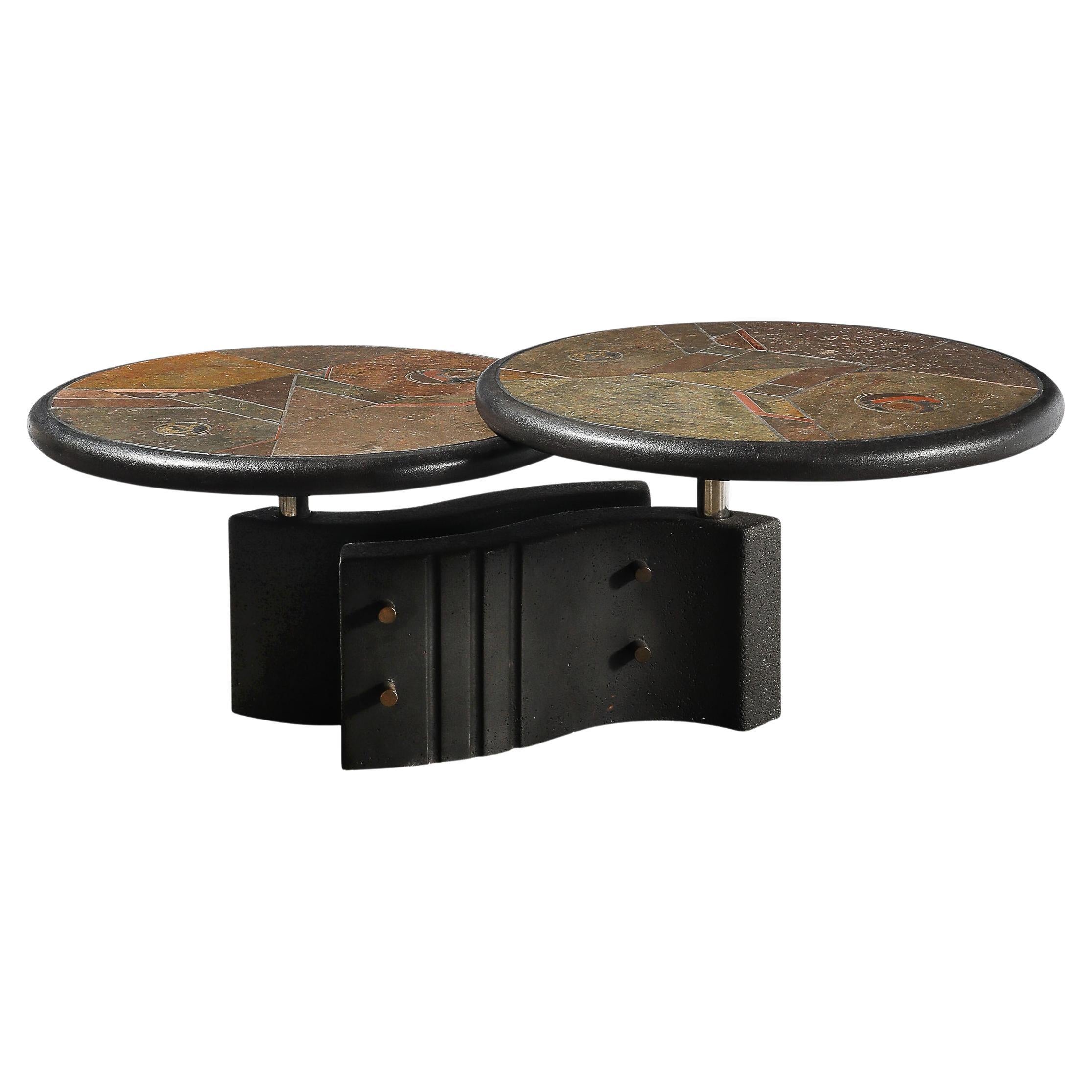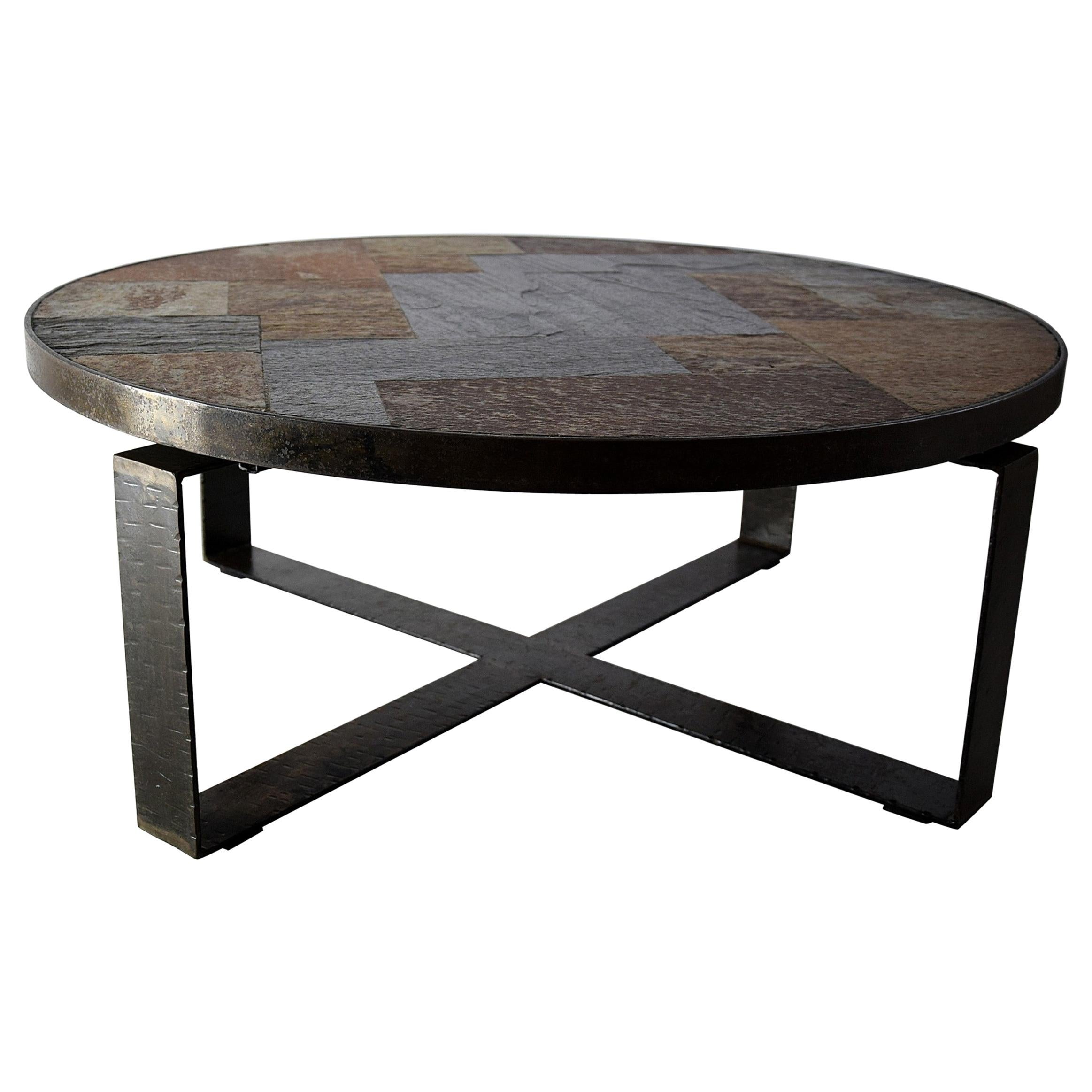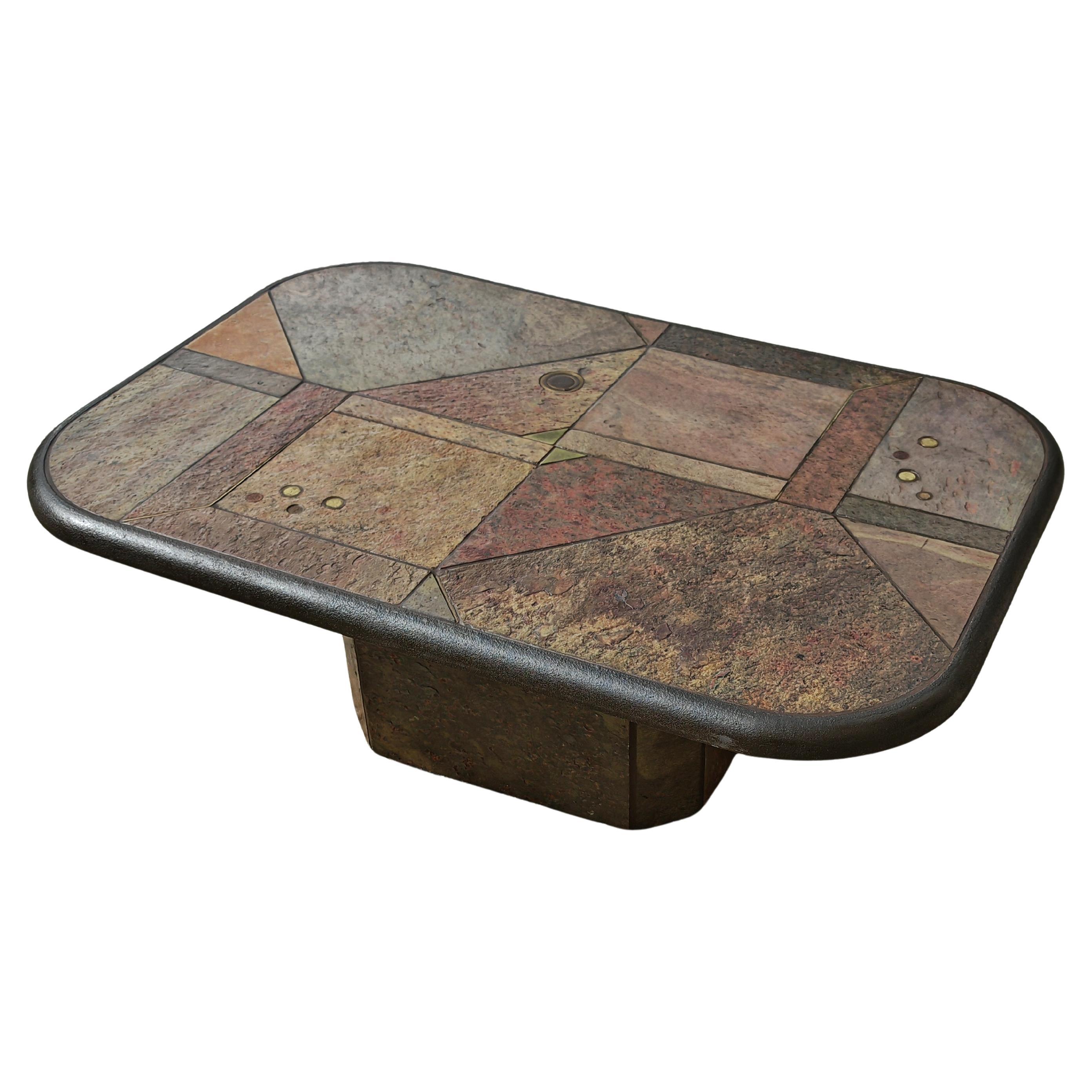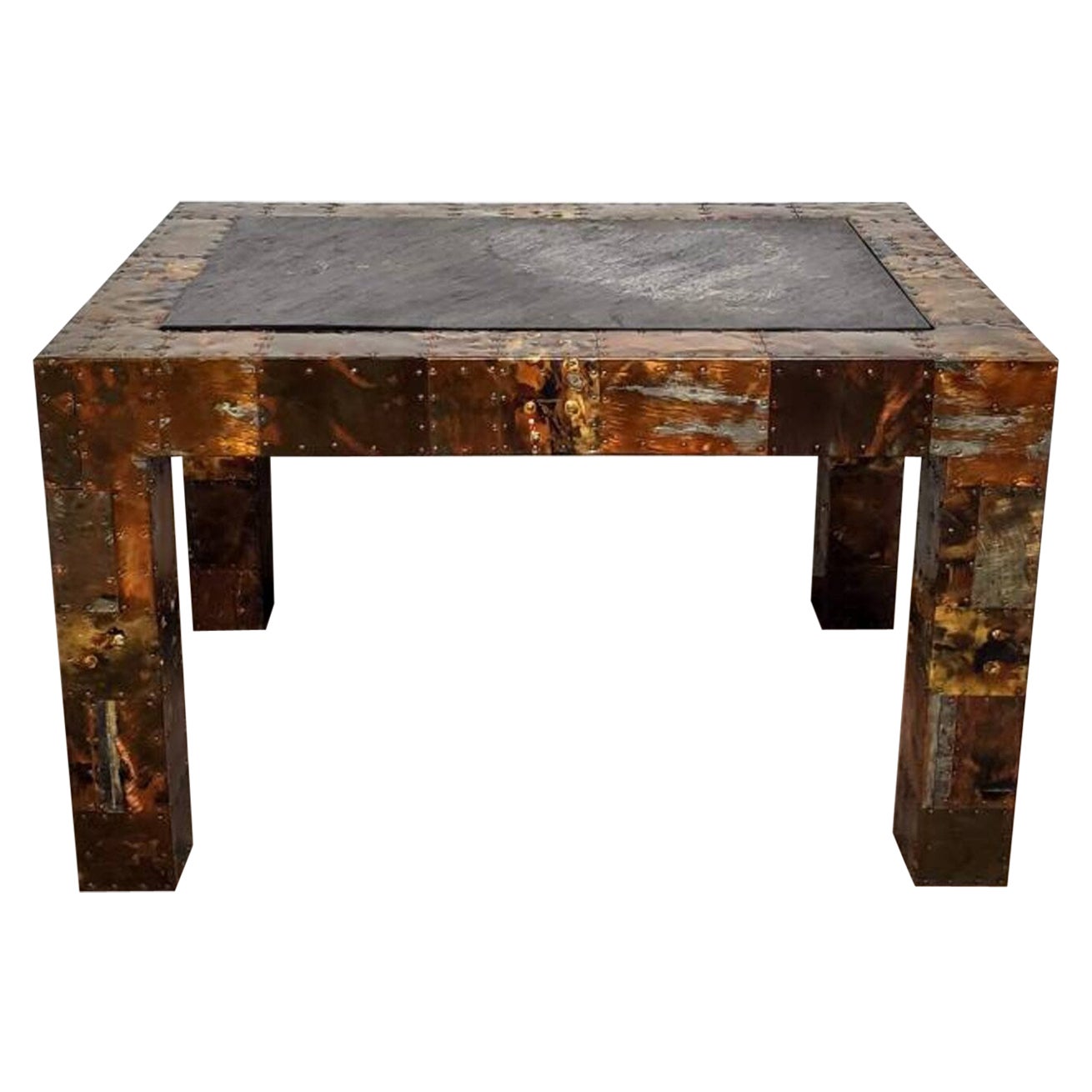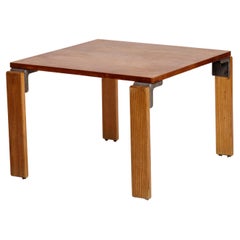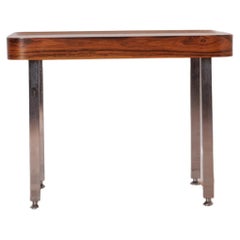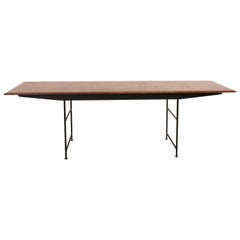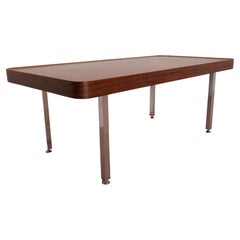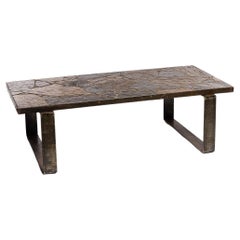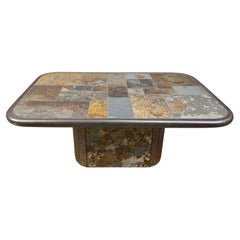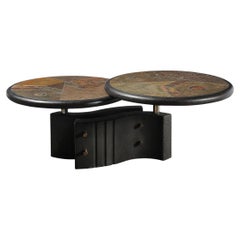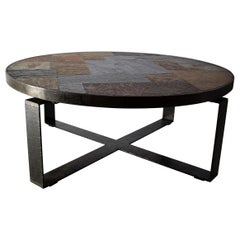Items Similar to Iconic Brutalist Paul Kingma Schist Center Table
Want more images or videos?
Request additional images or videos from the seller
1 of 9
Iconic Brutalist Paul Kingma Schist Center Table
$3,471.95
£2,576.21
€2,900
CA$4,849.10
A$5,258.97
CHF 2,762.21
MX$63,879.43
NOK 34,564.68
SEK 32,544.58
DKK 22,083.51
About the Item
Rectangular assembled schist table with rounded corners and brass inlay, very rare octagonal legs, signed on the top H: 47 cm Top: 80 x 120 cm.
Paul KINGMA (1931 - 2013)
Dutch sculptor and mosaist Paul Kingma (1931-2013) lived and worked in The Hague, Kortenhoef, Amsterdam, London, etc... and was an admirer of earth history and its natural creations, to which he paid hommage through his solid and massive tables which are the most renowned and iconic part of his production. Conceived as mosaic paintings, made from natural stones and materials he collected from all over the world, he produced them as "an independent design that can be used as a table afterwards as well".
- Creator:Paul Kingma (Designer)
- Dimensions:Height: 18.51 in (47 cm)Width: 47.25 in (120 cm)Depth: 31.5 in (80 cm)
- Style:Mid-Century Modern (Of the Period)
- Materials and Techniques:
- Place of Origin:
- Period:1980-1989
- Date of Manufacture:1980
- Condition:
- Seller Location:Santa Gertrudis, ES
- Reference Number:1stDibs: LU4513133988722
About the Seller
5.0
Vetted Professional Seller
Every seller passes strict standards for authenticity and reliability
Established in 2018
1stDibs seller since 2019
116 sales on 1stDibs
Typical response time: 10 hours
- ShippingRetrieving quote...Shipping from: Santa Gertrudis, Spain
- Return Policy
Authenticity Guarantee
In the unlikely event there’s an issue with an item’s authenticity, contact us within 1 year for a full refund. DetailsMoney-Back Guarantee
If your item is not as described, is damaged in transit, or does not arrive, contact us within 7 days for a full refund. Details24-Hour Cancellation
You have a 24-hour grace period in which to reconsider your purchase, with no questions asked.Vetted Professional Sellers
Our world-class sellers must adhere to strict standards for service and quality, maintaining the integrity of our listings.Price-Match Guarantee
If you find that a seller listed the same item for a lower price elsewhere, we’ll match it.Trusted Global Delivery
Our best-in-class carrier network provides specialized shipping options worldwide, including custom delivery.More From This Seller
View AllGeorges Candilis & Anja Blomstedt Coffee Table
By Robert Sentou, Anja Blomstedt, Georges Candilis
Located in Santa Gertrudis, Baleares
Iconic coffee table by Georges Candilis and Anja Blomstedt.
Furnishings for the vacation village Les Carrats in Port-Leucate. Designed and manufactured in 1969, then produced by Se...
Category
Vintage 1960s French Mid-Century Modern Coffee and Cocktail Tables
Materials
Aluminum
Isamu Kenmochi Coffee Table Chromed Metal and Japanese Walnut, 1969
By Isamu Kenmochi, Tendo Mokko
Located in Santa Gertrudis, Baleares
Isamu Kenmochi (1912-1971) was a Japanese modernist designer significant in the development of Japanese design after WW2.
Rare coffee table Chromed metal...
Category
Vintage 1960s Japanese Mid-Century Modern Coffee and Cocktail Tables
Materials
Metal
Italian Vintage Coffee Table by Isa Bergamo, 1950s
By ISA Bergamo
Located in Santa Gertrudis, Baleares
Pure and simple lines for this 1950s coffee table by ISA Bergamo in Italy in rosewood and black steel.
Category
Vintage 1960s Italian Mid-Century Modern Coffee and Cocktail Tables
Materials
Steel
Isamu Kenmochi Coffee Table Chromed Metal and Japanese Walnut, 1969
By Isamu Kenmochi, Tendo Mokko
Located in Santa Gertrudis, Baleares
Isamu Kenmochi (1912-1971) was a Japanese modernist designer significant in the development of Japanese design after WW2.
Rare coffee table Chromed metal...
Category
Vintage 1960s Japanese Mid-Century Modern Coffee and Cocktail Tables
Materials
Metal
Matthias Biberon Japanese Cedar & Oak Low Table 2024
By Matthias Biberon
Located in Santa Gertrudis, Baleares
These low table is a very special Matthias Biberon work, in Japanese Cedar and Oak. All joints are visible is the artist's signature in the pure Japanese influence of Mingei thought and Wabi Sabi. This is the beauty of the everyday object, one whose details we never tire of rediscovering.
Matthias Biberon (Paris, 1977) lives and works in Perche (Normandy / France).
He began working with wood in 2019, leaving behind photography and ceramics, which he had practiced successfully for many years. In wood, he finds the pleasure of imagining shapes and building them, with a combination of both naivety and attention to detail, and a freedom that neither conceptualism nor ceramics had given him. His furniture is organic, respecting the original shape of the wood and following its knots and veins. The search for balance and precision is one of the cornerstones of Matthias's work.
Carefully sourced, the wood types used - Oak, Elm, Cedar, Walnut - have been dried for decades, giving them an unrivalled patina. His trademark? Visible construction and the blending of materials, with stone a natural addition to his creations; for each of them, he seeks a form of balance, purity and softness, a functionality that is both poetic and sculptural, the simplicity and force of a haiku.
Passionate about art, it was while progressing towards Arts & Crafts that he embraced the aesthetics of functionalism, Mingeï and the thinking of William Morris. He is sensitive to the Arte Povera of Jannis Kounellis and Giovanni Anselmo, the Zen influence of John Cage, the freedom of Don Cherry...
Category
2010s French Other Coffee and Cocktail Tables
Materials
Oak, Cedar
Matthias Biberon Oak Dinning Table 2024
By Matthias Biberon
Located in Santa Gertrudis, Baleares
These Dinning Table is a typical Matthias Biberon work, old oak wood, well seasoned, a wood that has been dried for over 40 years, giving it a special patina. All joints are visible, the artist's signature in the pure Japanese influence of Mingei thought and Wabi Sabi. This is the beauty of the everyday object, one whose details we never tire of rediscovering.
Matthias Biberon (Paris, 1977) lives and works in Perche (Normandy / France).
He began working with wood in 2019, leaving behind photography and ceramics, which he had practiced successfully for many years. In wood, he finds the pleasure of imagining shapes and building them, with a combination of both naivety and attention to detail, and a freedom that neither conceptualism nor ceramics had given him. His furniture is organic, respecting the original shape of the wood and following its knots and veins. The search for balance and precision is one of the cornerstones of Matthias's work.
Carefully sourced, the wood types used - Oak, Elm, Cedar, Walnut - have been dried for decades, giving them an unrivalled patina. His trademark? Visible construction and the blending of materials, with stone a natural addition to his creations; for each of them, he seeks a form of balance, purity and softness, a functionality that is both poetic and sculptural, the simplicity and force of a haiku.
Passionate about art, it was while progressing towards Arts & Crafts that he embraced the aesthetics of functionalism, Mingeï and the thinking of William Morris. He is sensitive to the Arte Povera of Jannis Kounellis and Giovanni Anselmo, the Zen influence of John Cage, the freedom of Don Cherry...
Category
2010s French Other Dining Room Tables
Materials
Oak
You May Also Like
1970 Steel and Stone Table by Paul Kingma
By Paul Kingma
Located in Schoorl, NL
This raw and brutalist design is iconic for Kingma. Slate stone top with unpolished concrete finish resting on a steel frame.
Category
Vintage 1970s Dutch Coffee and Cocktail Tables
Materials
Stone, Steel
Paul Kingma attributed coffee table, 1980s
Located in Leuven, Vlaams Gewest
Brutalist slate and natural stone top coffee table with inlaid copper and brass.
Stone slate base
The table is signed but we cant identify the signature.
Good condition.
Very muc...
Category
Vintage 1980s German Brutalist Coffee and Cocktail Tables
Materials
Stone, Brass
Mid-Century Brutalist Articulating Stone & Metal Cocktail Table by Paul Kingma
By Paul Kingma
Located in New York, NY
This extraordinary Brutalist cocktail table, designed by the renowned Dutch artist Paul Kingma in the 1980s, is a striking example of his signature style, which masterfully combines ...
Category
Vintage 1980s Dutch Mid-Century Modern Coffee and Cocktail Tables
Materials
Stone, Metal
Mid-Century Modern Slate and Brass Coffee Table
By Paul Kingma
Located in Weesp, NL
Mid-Century Modern coffee table by Paul Kingma.
Slate stone Brutalist coffee table designed by Paul Kingma in the 1960s.
A "mosaic" of different sizes slate stone, so called Sell Pi...
Category
Vintage 1960s Dutch Mid-Century Modern Coffee and Cocktail Tables
Materials
Slate, Brass
Large Brutalist coffee table in various kinds of stone by Paul Kingma, 1980s
By Paul Kingma
Located in Beograd, RS
In this listing you wilk find a stunning Brutalist table designed by Paul Kingma. The table is done in various kinds of stone, with brass accent and coins inserted in the stone, one ...
Category
Vintage 1980s Dutch Brutalist Coffee and Cocktail Tables
Materials
Stone, Brass
Paul Evans American Mid-Century Brutalist Coffee Table
By Paul Evans
Located in Forney, TX
Paul Evans (1931-1987) American Brutalist industrial modern welded steel, copper, mixed metals patchwork coffee table with rivet accents and i...
Category
Late 20th Century American Brutalist Coffee and Cocktail Tables
Materials
Slate, Metal, Copper, Steel
More Ways To Browse
Round Corner Tables
Rounded Corner Table
Hunzinger Table
Maxie Lane
Meeks Center Table
Money Changer Table
Octagon Center Hall Table
Rococo Table Marble Turtle
Round Mahogany Breakfast Tables
Round Tavern Table
Sheraton Drum Table
Sorrentino Table
Square Library Table
Wheat Sheaf Center Table
20 Century Henredon
36 Round Antique Table
40 Inch Round Mirror
42 Inch Round Foyer Table
